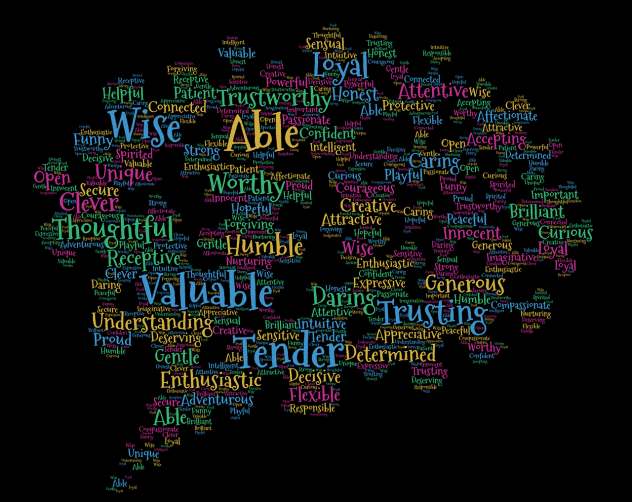Earlier this year I connected with other educators who like to blog. We came together over #sunchat, a Twitter-based Sunday morning chat. We called ourselves the #Sunchatbloggers! We provide each other with feedback and encouragement. Someone in the group suggested we all post on the same topic: our “Top 5”. Some people will post about strategies, others activities, others technologies—I’ve decided to focus on “needs”.
What are my 5 “essentials” for effective teaching?
After much reflection, I’ve identified my 5 teaching must-haves:
Trust
Engagement
Assessment
Curiosity
Hope
I need Trust.
 We know that the world works—quite literally—because of relationships. We also know that a primary—if not the primary—determinant of students’ academic success has to do with the relationships they cultivate in the learning environment. When I teach I strive to nurture strong, positive interpersonal relationships. When I teach I also strive to nurture pedagogical relationships; these are emotional connections between my students and the knowledge they are learning. The flourishing of both of these kinds of relationships depends on trust. I can only get to know my students if they trust me. If my students trust in my intention to support their learning process, I can challenge them. I can encourage them to take risks in their learning. I aim to push my students outside of their “comfort zone”—a pedagogy of discomfort! My students need to know I have their best interests at heart if they are going to learn and enjoy new ideas, new ways of being, unfamiliar terrain etc. They need to see me modeling my support through flexibility and diversity in my teaching plans, assessment and evaluation practices.
We know that the world works—quite literally—because of relationships. We also know that a primary—if not the primary—determinant of students’ academic success has to do with the relationships they cultivate in the learning environment. When I teach I strive to nurture strong, positive interpersonal relationships. When I teach I also strive to nurture pedagogical relationships; these are emotional connections between my students and the knowledge they are learning. The flourishing of both of these kinds of relationships depends on trust. I can only get to know my students if they trust me. If my students trust in my intention to support their learning process, I can challenge them. I can encourage them to take risks in their learning. I aim to push my students outside of their “comfort zone”—a pedagogy of discomfort! My students need to know I have their best interests at heart if they are going to learn and enjoy new ideas, new ways of being, unfamiliar terrain etc. They need to see me modeling my support through flexibility and diversity in my teaching plans, assessment and evaluation practices.
I need Engagement.

Effective teaching and learning require the emotional engagement of my students and me. Emotion is the mind’s rudder. Tie knowledge up with some human emotion and it becomes meaningful and memorable. So, in order to teach, I need “cognitive tools”—learning tools that engage my students’ emotions and imaginations. I employ tools of oral language, tools of written language, and tools of philosophic and ironic understandings to connect my students’ emotions and imaginations with the content of the curriculum. These tools forge pedagogical relationships based on wonder; they are long-lasting. My students are constantly engaging their imaginations in learning the content of the curriculum. (Learn more about Dr. Kieran Egan’s Imaginative Education pedagogy here.)
I committed some educational blasphemy just now…did you notice? An important piece of the engagement piece is that it starts with me. I know, this isn’t the currency in teacher talk—we must always start with the student, right? Well, I challenge that idea. Students know when their teachers are not engaged. If I want to create a learning context that maximizes my students’ engagement—and learning—I must also be engaged in the subject matter. I need to find a source of emotional significance within the topic so I can create an imagination-focused context for my students. Whatever the topic—Quadrilateral equations in Math? Haiku poetry? Educational Change in Theory and Practice?* (*what I am currently teaching)–it is essential that I approach curriculum topics with affective alertness. I seek an emotional connection—what stirs my sense of wonder? In order to emotionally engage I need to have depth of knowledge in my subject matter—and a commitment to gaining this if need be.
I need Assessment.

I cannot disconnect effective teaching from effective (caring, constructive, formative) assessment. Ongoing assessment of my students is part of my daily teaching practice. I need to know what where my students “are”: what they need, what they want, and what they can handle in order to make my pedagogical decisions. More “formal” assessment (though no less important for teaching) comes in the form of my feedback on their work. I believe my students will learn most if my feedback is ongoing, constructively critical, positive, rich, and timely. But I don’t just assess my students—I ask that they provide me with feedback as well. My teaching “plans” need to be flexible to suit the needs and interests of my students. So I plan with flexibility and maximum space for diversity in mind and then I ask for feedback. I need to be able to adapt my plans mid-stream and, always, take summative student feedback and revise entire courses as needed. I need their feedback to be an effective teacher.
I need Curiosity.
 I believe love of learning stems from curiosity. It’s the disposition we need as teachers. It’s the disposition we want to see in our students. I believe the world is wonder-full. Our curricula is wonder-full. Topics that may seem on the surface to be “ordinary” are in fact richer—and more interesting–than we will ever fully understand. And here’s the contradiction: educators want to support a love of learning in their students, and yet, many don’t demonstrate a love-of-learning themselves. They look at knowledge as mundane, topics as boring, and they often teach things to students “because it’s important to know this”. Every topic can be seen in a light that shows it as unique. Every topic glimmers with wonder. (Yes, even “paragraph writing” or “punctuation”.) Curiosity brings joy to my teaching.
I believe love of learning stems from curiosity. It’s the disposition we need as teachers. It’s the disposition we want to see in our students. I believe the world is wonder-full. Our curricula is wonder-full. Topics that may seem on the surface to be “ordinary” are in fact richer—and more interesting–than we will ever fully understand. And here’s the contradiction: educators want to support a love of learning in their students, and yet, many don’t demonstrate a love-of-learning themselves. They look at knowledge as mundane, topics as boring, and they often teach things to students “because it’s important to know this”. Every topic can be seen in a light that shows it as unique. Every topic glimmers with wonder. (Yes, even “paragraph writing” or “punctuation”.) Curiosity brings joy to my teaching.
I need Hope.
Education matters. It’s the vehicle through which human beings not only learn to adapt but learn to thrive. Education changes people, “norms”, institutions—it is a means for social justice and a more ethical world. Effective teaching doesn’t involve passive “hoping” for a better world; teaching is hope in action.
See what imagination-pedagogy looks like for K-postsecondary. Get weekly updates from imaginED!



“Teaching is hope in action.” Hadn’t thought of it that way before; can’t stop thinking about it that way now.
Hi Brian–thanks for reading it. I feel like it kind of is…came to me as I was identifying (for myself) the overall narrative shaping much of educational reform initiatives. And then the teaching is where it all actually happens. 🙂
Fantastic piece! I agree 100% that engagement starts with ME. Engagement is contagious, and my passion for learning can ignite a great fire! Thanks for sharing!!
Thanks for commenting Susie. Even the most child-centered approaches need to remember the teacher! 🙂 Contagious is right!
The Curiosity section was an unexpected yet plesant surprise here. It’s so important for teachers to nurture and preserve a student’s nature wonder. Thanks for posting.
I connected with your I need Assessment section. It’s very forward thinking that we need our students’ feedback in order to be effective teachers. As I’m working on my action research project on standards based grading my qualitative data from students indicate that very few teachers ask for student input on their teaching practices. Why isn’t this a common teaching practice? If we assess our students in order to see if they are learning then what prevents teachers from asking students to assess teachers? I teach at the high school level but I think it can be done even as early as the elementary level. Your post has given me more insight to inform my project. Thank you for sharing!
I really appreciate this feedback. Thank you! It just seems that we talk a lot about being lifelong learners…well we are only “learning” our way through this profession! Get feedback and learn better? Let me know if you try it out!
To paraphrase John Hattie, the goal is to help students be “teachers” of their own learning and teachers to be “students” of their instruction.
There is another way to think about motivation – not as a cause but as a consequence of achievement, Dylan William (2011).
Assessment not only informs the teacher of the learning that happens during instruction, but more importantly, informs the student of their success in learning, building confidence and building hope. When assessment is designed with planned engagement up front, based on the culture of the school and the interests of the student, both the engagement and the trust pieces are addressed. Our primary purpose in school is to provide a rigorous learning environment for the students. Assessment, primarily formative use, is central to this process. A response is always required by the teacher and the student – next steps built, and another round of looking at new evidence of learning. This builds a trajectory of hope. Teaching as hope in action must transfer to learning as hope in action.
I love your last point of hope. I think this is what draws us to education in the first place, but can often get lost among the initiatives, the paperwork, and the constant “everything” that comes with our jobs. Thanks for the great reminder of why we do what we do!
Thanks for the positive feedback Aubrey. I agree with you–and I think hope is why we also seek change. Comes from a source of good intentions 🙂
Gillian, I love the way you identify what we need from our students and show us how our students need the very same things from us: if we want our students to be engaged, we must show engagement; if we want to be effective teachers, not only do we have to give our student meaningful feedback, but we have to be open to their feedback; if we want our students to be curious, we have to model curiosity. On Monday I have to sub for a teacher who resigned unexpectedly and I’ll take your 5 needs into the classroom with me as my guiding light. I’m excited to work as a teacher again and to have the opportunity to be “hope in action.” #sunchatbloggers
Good luck tomorrow Carla–I’m sure you’ll have a great day. Thanks for your positive feedback. You ARE hope in action!
In reading through this I just wanted to jump up and down..Me too! Our kids need these same things. It’s good to step back and reflect and in thinking about our own needs look at how our kids are not much different! Spelling out the acronym TEACH is beyond brilliant! Nicely done.
Nice to have you jumping up and down there with me Joanne 🙂 Thanks for commenting and for your support!
I cant stop reading, it is a great of inform.
HI Daniel! so what are you TOP 5? Please share! I would love to know–I’d like to get people talking about their #top5. Each one is a great discussion point for educators.
Interesting mention about planning being flexible. In today’s teaching the drive is structure held in by the rigid scaffold of what is the scheme of work (Sow). We draw up a SoW based on the specifications of the units/modules we deliver and when each topic is taught and in what sequence. But who needs a SoW in this format? Mangers, just in case you are off and someone else needs to take over your lessons then the replacement can just fit in seamlessly! As if plans go according to a set of rules we set out in the July before the Autumn term even starts. A teacher needs flexibility but the constraints of the curriculum and the time provided to deliver forms a tight band to halt any such thoughts. However, we teachers know best and try to build in flexibility even if it is to try something new that we may not have known about last year.
I ALWAYS appreciate your comments Chris 🙂 Thanks for taking the time. Bit of a contradiction to talk “planning” (think blueprints, lines etc.) and flexibility. True. But, as you point out, it comes from the disposition of the teacher. The push in BC, Canada, for inquiry-driven learning aligns with a flexibly-minded teacher. Can’t pre-plan Ss’ inquiry directions–unless we aren’t fully embracing inquiry. But we are also mandated to “cover” different topics–whether K-12 or post secondary. A challenging position with many contradictions. And all this being said…I plan. I like to be prepared. But I want to be able to adapt–if not, I’m not teaching to my Ss needs.
Selflessness
Positive energy
Absolute truth
Respect
Kuungana (Swahili for connection)
Selflessness requires that we die to our own desires in favour of something larger than ourselves. In learning, we must surrender to an idea that has value beyond the immediate benefit to us. In doing so we may then uncover meaning that may have absolutely nothing to do with us, but be significant in a larger context. Selflessness requires that we remove ourselves from the centre of the universe and understand things from a different perspective. Its opposite is not selfishness, but rather centricity.
Positive Energy brings growth, understanding, cooperation, striving, light and is life giving.
Absolute Truth. In Science, we say that there is no such thing as absolute truth and yet we keep searching for it. The pursuit of Science at its core is the search for an objective reality based on verifiable evidence that cannot be denied. A life spent in the pursuit of the unattainable is a life well spent.
Respect is the foundation of all relationships. Whether it is a relationship between people or to an area of study, there must be respect if anything is to be achieved.
Kuungana is Swahili for connection. When I am speaking and students are not listening, as a joke I often say “Am I speaking in Swahili again? No wonder you are not understanding me!” But then I realized that if students have no connection to or sense my own disconnect from what I am trying to teach, then our endeavors are futile!
Ah Judy! This is beautiful. I totally understand and appreciate your choices–and for someone approaching the end of a very rich career, these #top5 things have made you the great teacher that you are!